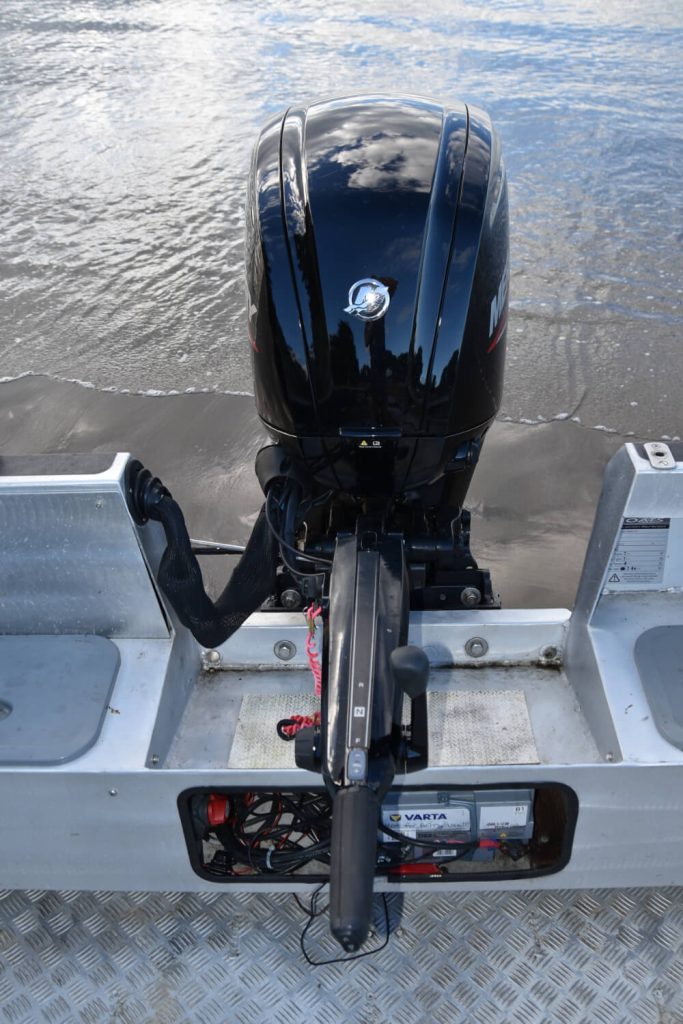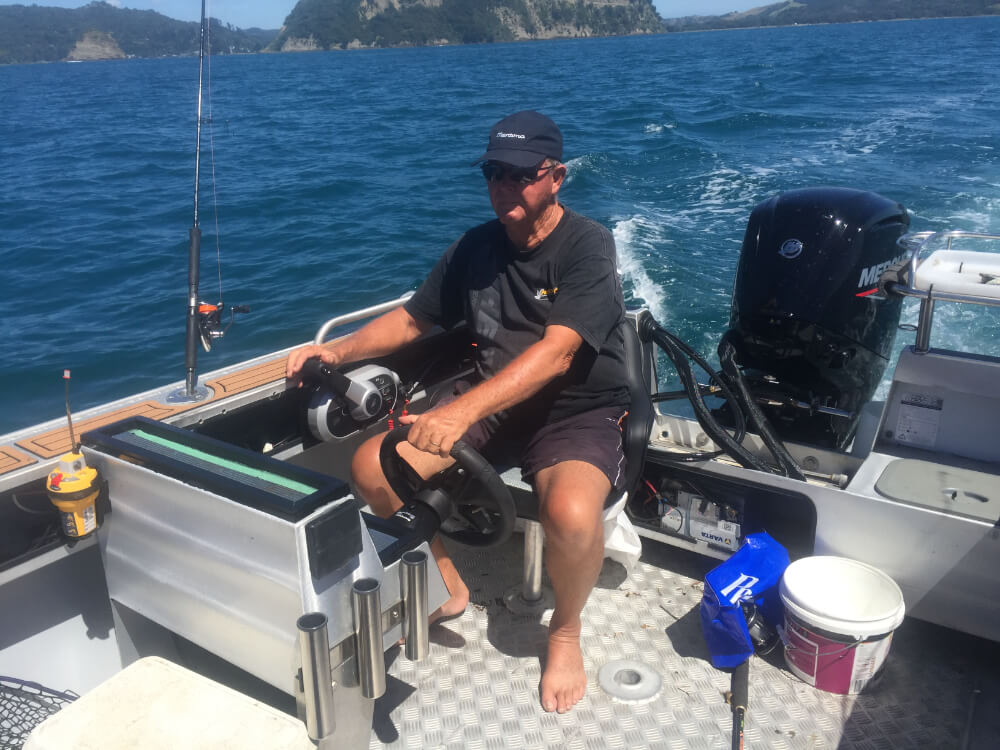Text by Barry Thompson
After five seasons of driving my McLay 480 Fortress with a tiller, I finally changed and went to a conventional steering wheel. While I loved driving the boat with a Mercury Big Tiller, bolted up to various Mercury outboards, I felt it was time for a change.
When I first took delivery of my McLay straight after the 2015 Hutchwilco NZ Boat Show, it was powered by a tiller steer Mercury 60hp outboard. I liked the setup as I didn’t need a centre console that I always felt took up valuable fishing space. After five years, I am still of that opinion and love the side console-setup.
The power was originally a Mercury 60 with a standard tiller, which was fine. However, as I increased the engine’s horsepower and with it the boat’s speed, I found at a specific trim, there was a lot of pressure exerted from the tiller. Today I have a Mercury 90 4 S, which is probably a bit of an overkill, but the boat handles it well. I also upgraded to the Mercury Big Tiller, which has all the trim, tilt, start, stop and gears on the handle. Great piece of kit that is a must if you are running a larger engine.
Last year I replaced the Big Tiller with Mercury Marine’s new multi-function tiller, their most feature-packed tiller arm ever. While a tiller steer is not the option for everyone, I have found it ideal for my boating style over the past few years. Mercury’s first Big Tiller was released in 2007 and was rated for up to 250 hp. The die-cast aluminium arm was designed to withstand a 400-pound load, and it was a huge success for Mercury. After 13 years, it was retired, and its predecessor is packed full of features, which make it one of the most advanced outboard tillers on the market.


The new Mercury Tiller is suitable for 40 to 250 horsepower outboards, including the 40-150 hp Mercury FourStrokes, the complete OptiMax Series, including Pro XS models and 135-200 hp four-cylinder Verado engines with SmartCraft Digital Throttle & Shift (DTS).
Mercury uses the same 2.1 litre in-line four-cylinder engine platform for their Mercury 4 Stroke series from 75-115hp, so the weight has not increased with the horsepower changes. Flat out, pulling 5500 rpm, running a Spitfire X7 13.5″ 4 bld propeller, top speed is 32 knots, which is heaps fast enough. I do most of my driving around 4500 rpm @ 25.5 knots, or if a bit rough, I drop that back to 4000 rpm @ 23 knots.
If the water is calm, I can set the trim up from the rocker switch on the tiller, so I have virtually no feedback through the tiller. However, if I have to trim the engine to level the boat, it gets to a point where there is too much feedback through the tiller to drive comfortably. A lot of pressure on my 71 year old arm! Maybe I am just getting lazy, but I thought after a couple of ‘hard’ drives back home last season after a day’s fishing that I would explore changing to a traditional steering setup. Unfortunately, Mercury doesn’t offer a power steering option for my 90hp (it starts from 115hp upwards).


REGULAR HELM
Changing to a standard steering system was easy as I already had a side console on the boat. A few seasons back, I brought a console from McLay Boats, so I had somewhere to mount the Humminbird Helix 9 sounder, a glove box and a couple of Mercury instruments. Previously I had made my own console, and while it worked well, it was looking a little worse for wear after a few seasons. The new side console was an easy fit, although I lowered it down somewhat from how they are typically mounted in the McLay Fortress because I was not running a steering wheel. Well, not until now.
When changing to a steering wheel, the first alteration was to move the helm forward 120mm, so I had enough space behind for the wheel and the new helm seat. I kept the low profile, and you can hardly see the helm or wheel from a side view. I replaced the plastic seat with a Springfield moulded seat on a low-profile sliding base. I also needed a new pedestal to set the seat up at the right height. While the driving position is probably lower than you would typically find in a boat this size, I like it, and it has proven a comfortable driving position.


SEASTAR HELM
Next, I needed thing to sort out the right helm. That was easy as I asked McLay what they ran in their side console Fortress and got the same make and model. A quick call to BLA, the distributors for the Dometic Seastar range and I soon had a Dometic SeaStar hydraulic system complete with a Gussi 310 soft grip steering wheel.
The SeaStar Hydraulic steering system is designed to provide that extra margin of muscle when needed and easily handles outboard, sterndrive and inboard engines in boats up to 15m. Perfect match for my setup.
The system selection, installation and service are substantially simplified with just three major components – helm, cylinder and tube or hose. SeaStar has a comprehensive range of available cylinders to handle various steering applications, and as my boat is so light, I only needed the fundamental Baystar system.
The BayStar hydraulic steering is rated up to max 150HP. It consists of a super low friction helm for smooth, comfortable steering a balanced cylinder–featuring a compact design that fits most splashwells.
And what a difference! No more feedback on the tiller with precision control. The lack of steering effort, due to considerably no doubt to Seastar’s patented No FeedBack steering lock valves, has transformed my driving.
I also no longer have to sit a little sideways when driving, with the fixed helm now allowing me to face straight ahead. So it feels more natural and saver. I always ran with the kill switch attached to my wrist in the past, as if I let the tiller go, the boat would flick sideways so fast I could easily be thrown out. Even though I have a steering wheel and positive helm, I still do the same when I let the wheel go, especially when I am on my own.
The lower steering effort has been a winner, and I am pushing the boat a little harder in the choppy water than I did with the tiller. The Mercury control unit was an easy fit to a side panel that I fashioned from a piece of alloy I had in the garage. I fixed it with rivnuts so it would be easy to remove if I needed to get into the shelf space behind it and covered it in black paint.
Once everything was in place, I got the team at Mercury Marine to attach up all the steering hoses and control cables to make sure it was done right. And it was. The boat is a breeze to drive, and I love it. Well, that’s when I can get out between lousy weather and the fact that I had a total knee replacement at the beginning of January, so I did not go boating for two months. I can’t wait to get back out there and into those fish.




